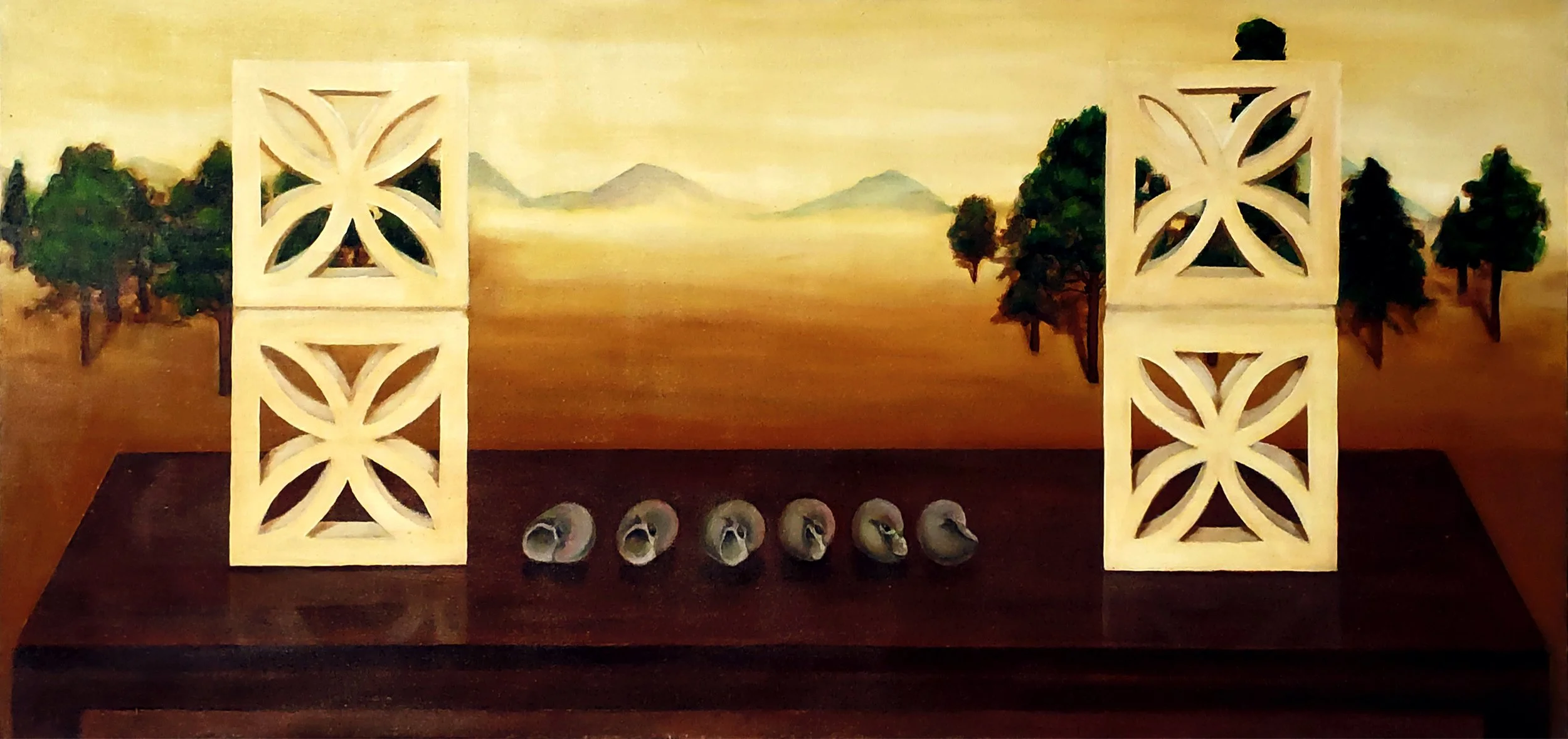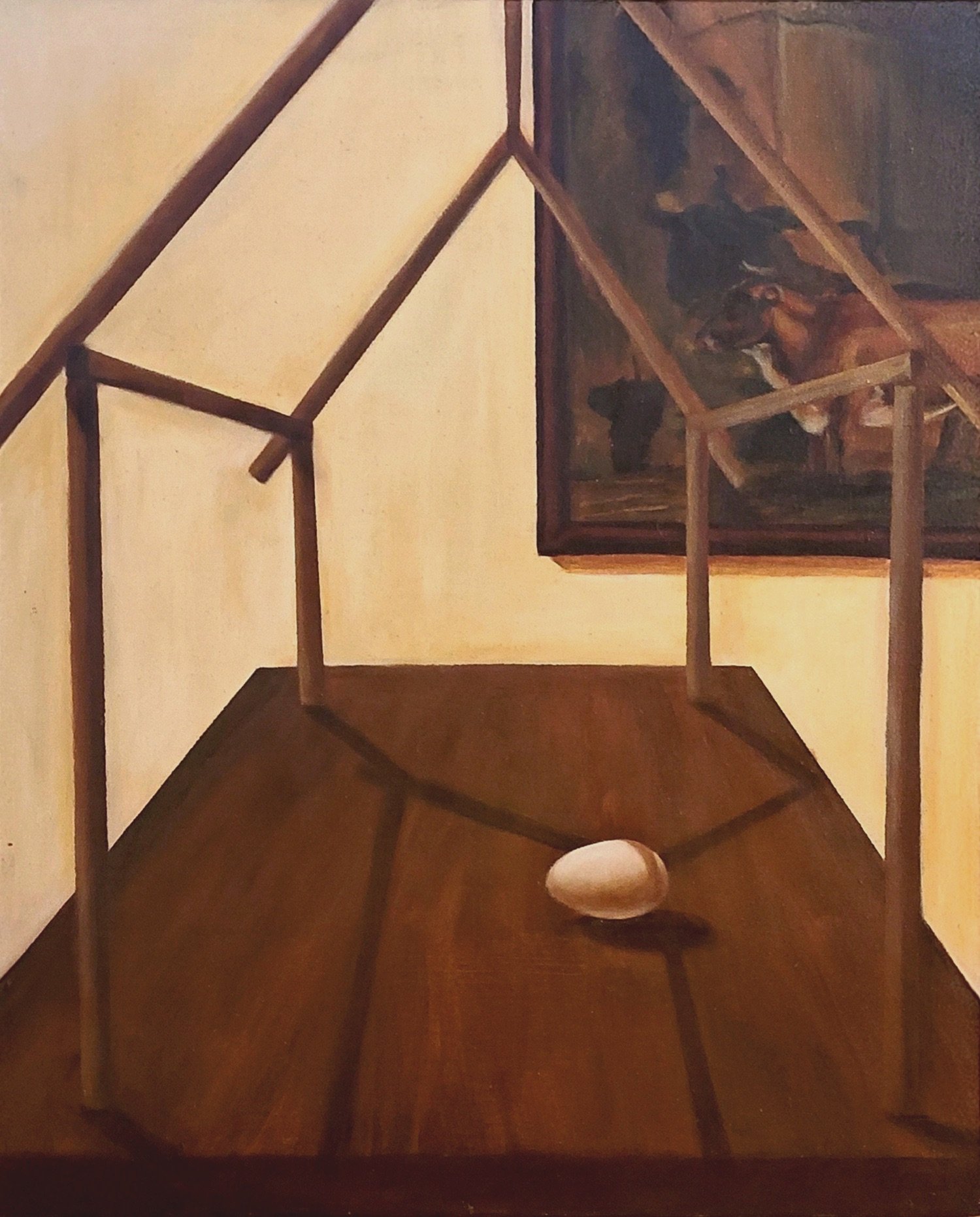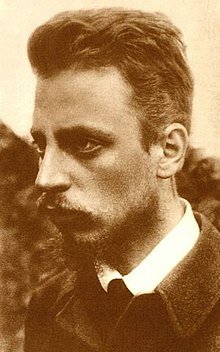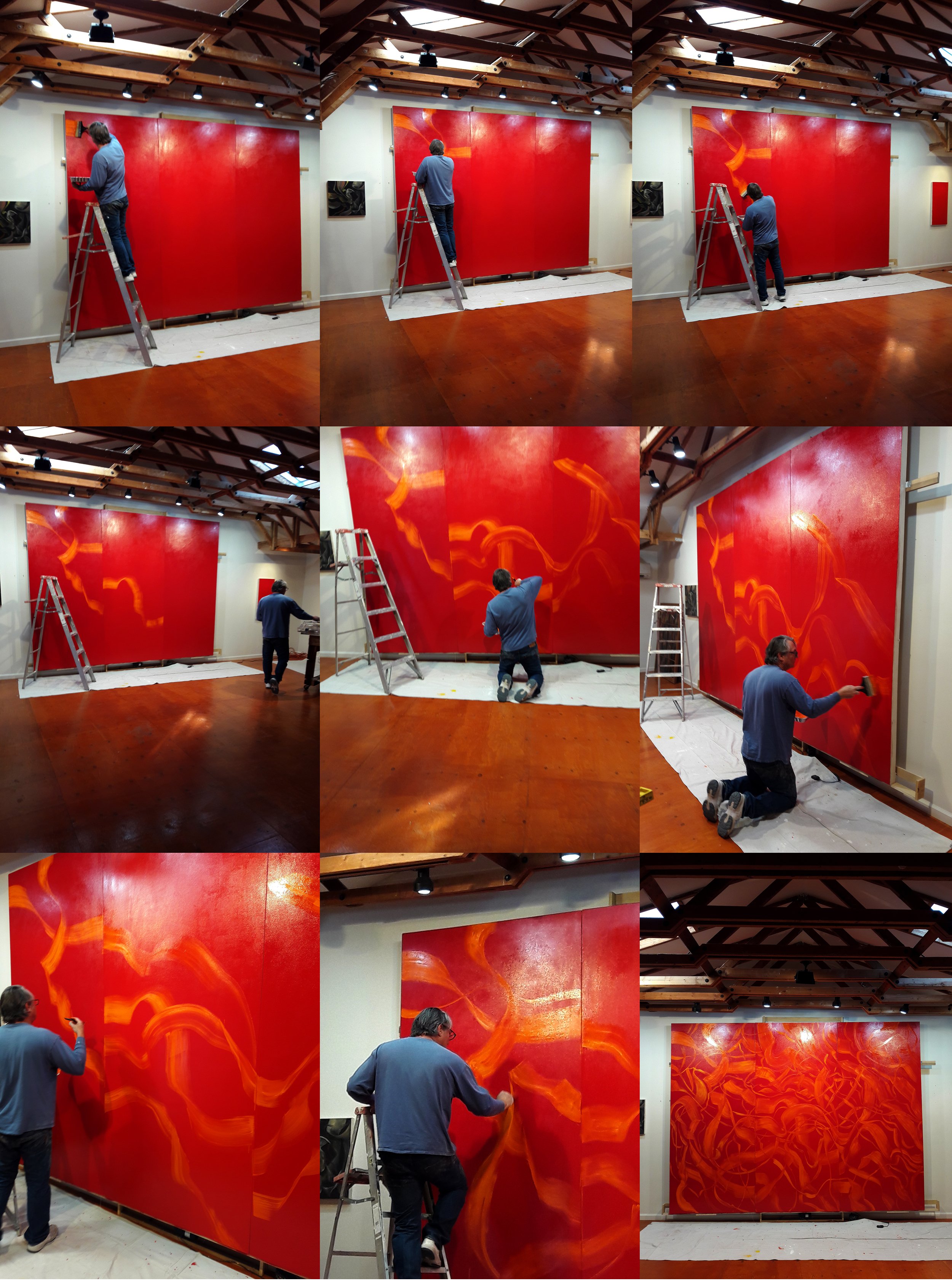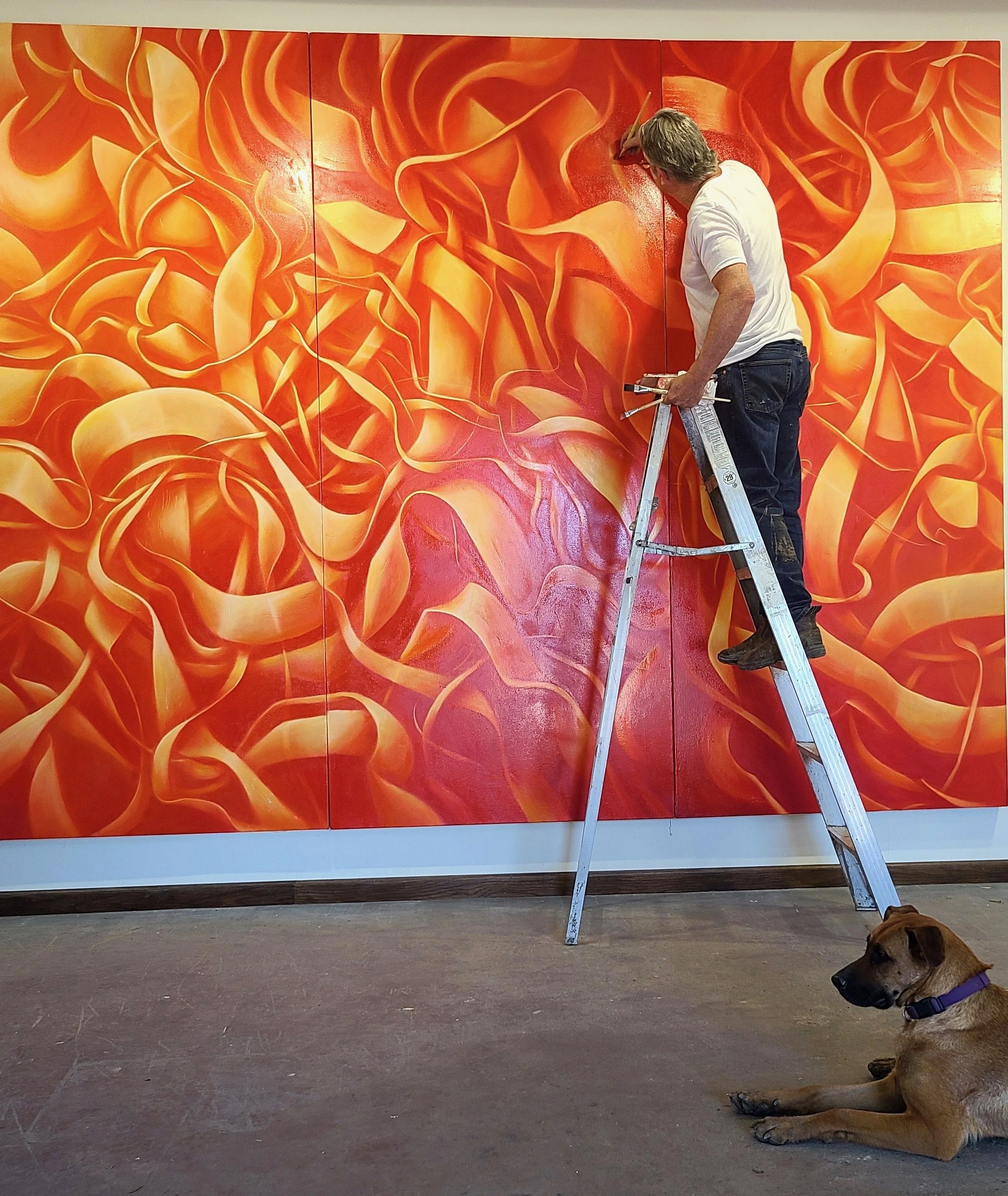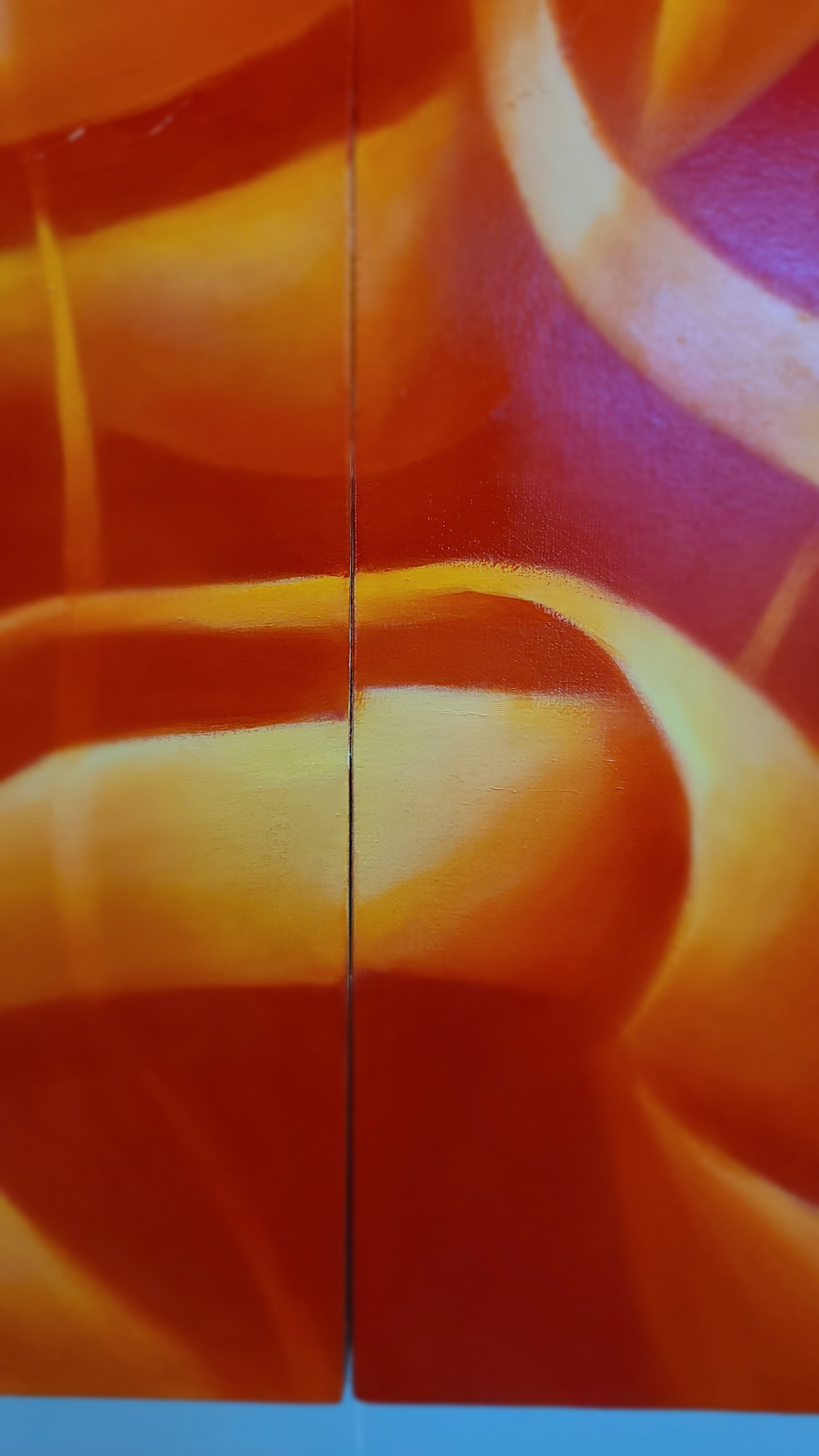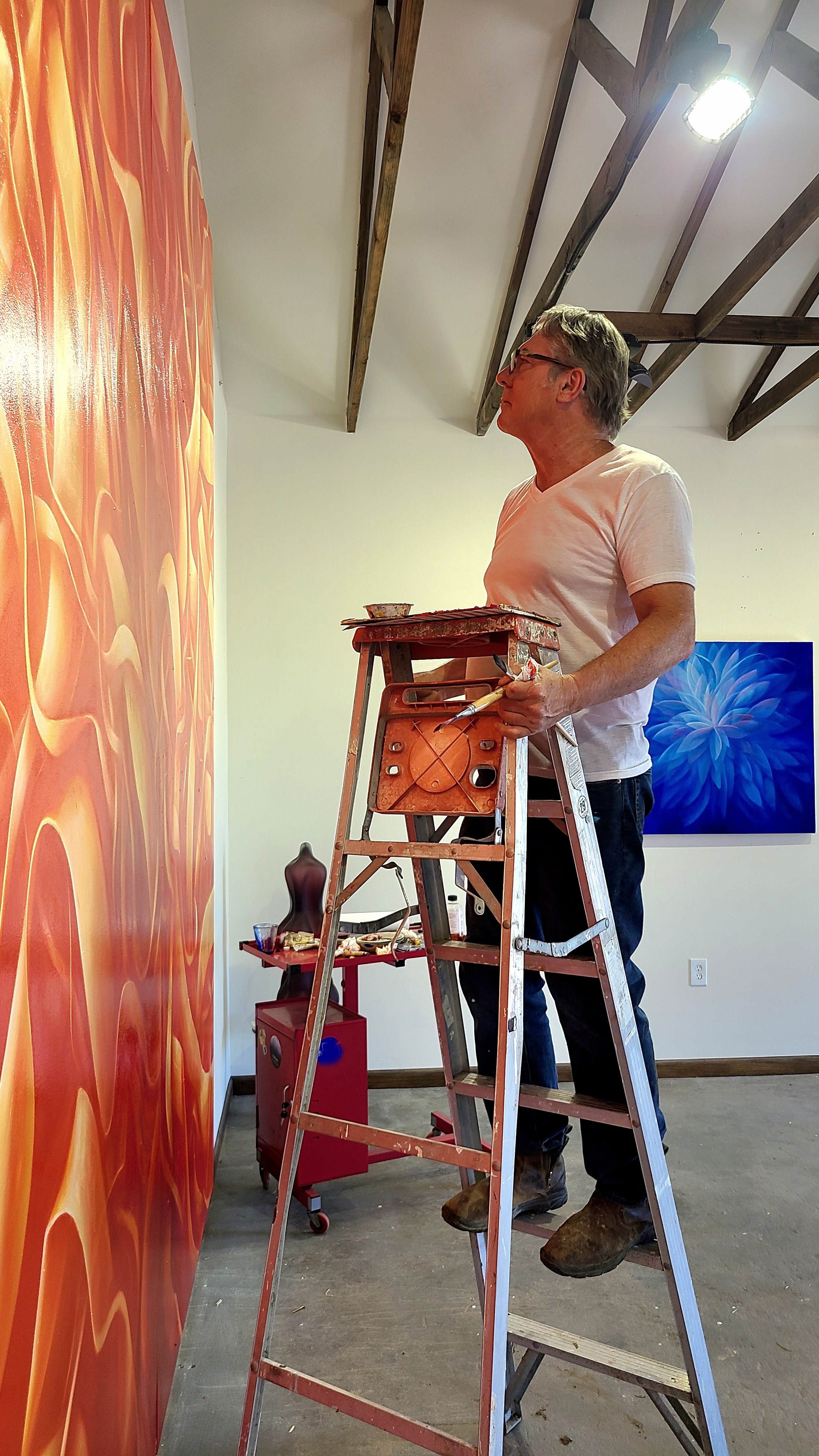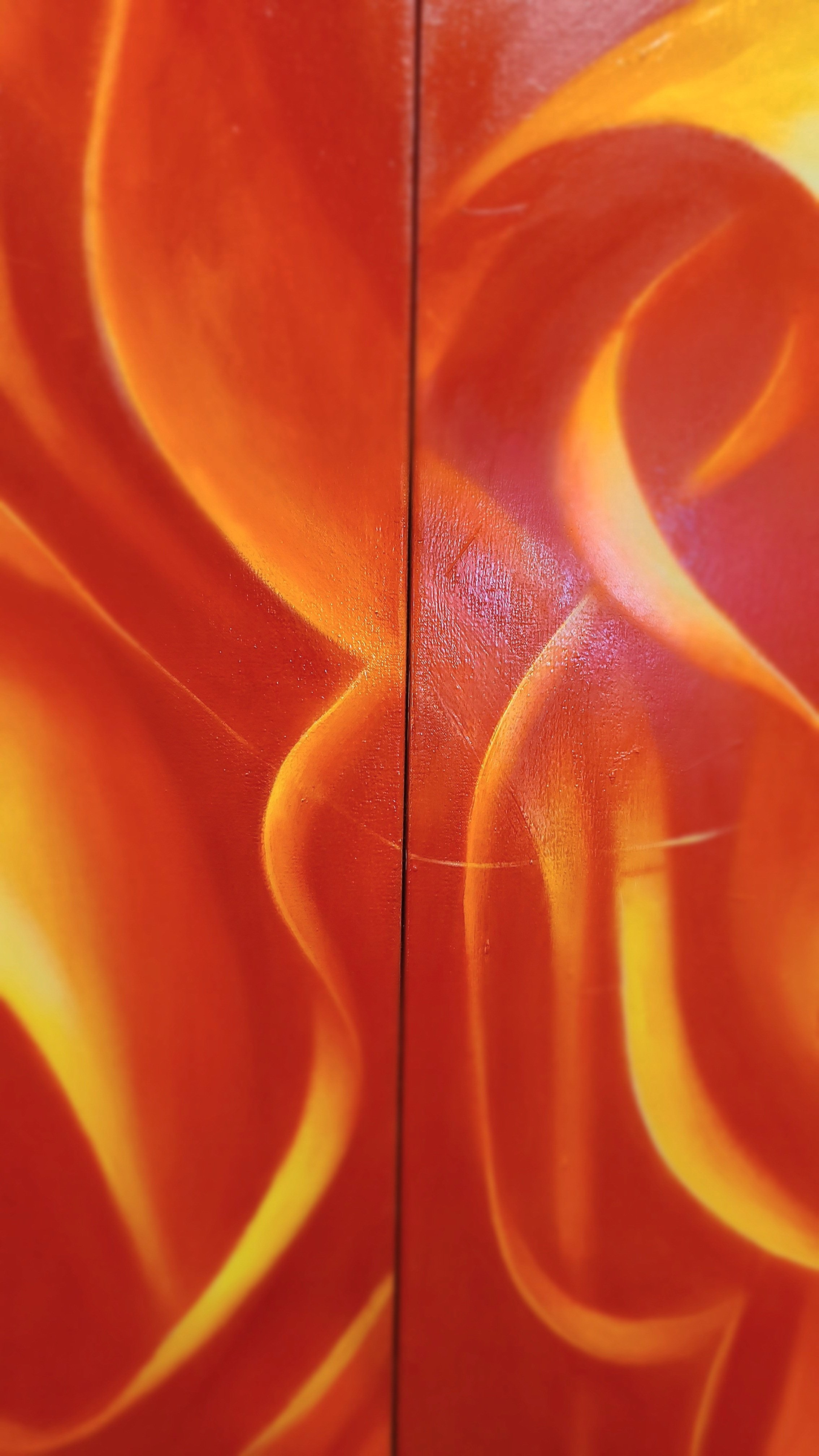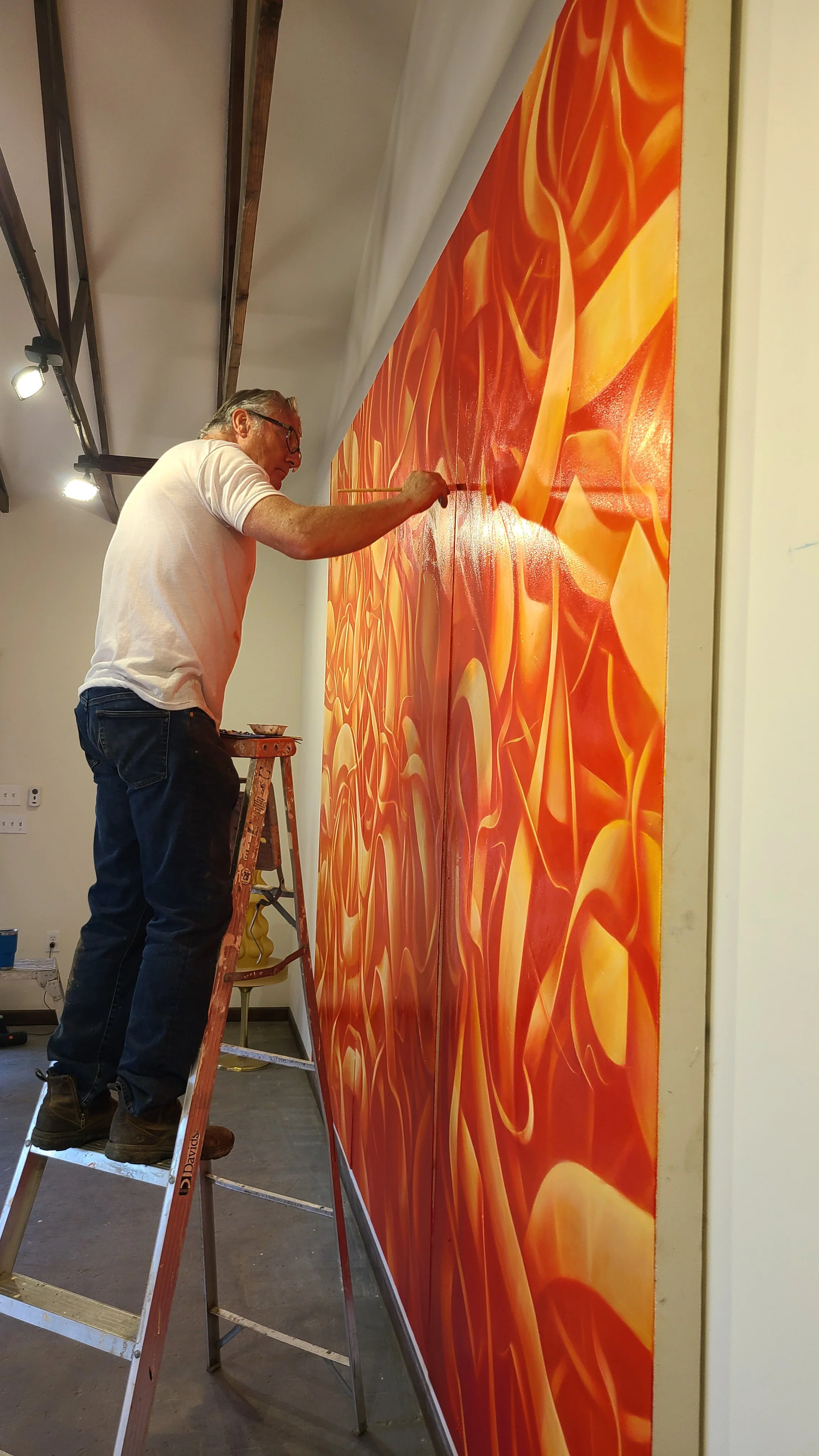A Conversation between the Victoria Chapman (VC Projects) and Shane Guffogg
Introduction
Last month we began a discussion about the studio process, and the conscious efforts to create art. In Part 2, we continue with Hegel’s text from Phenomenology of Spirit, (1807) contemplating appearance and the supersensible world; when one loses themselves to the senses. Interestingly, Hegel’s book was written as a guide to define awareness as it pertains to truth and is one of the most popular philosophical texts discussing the history of consciousness.
We also discuss the first letter in Rilke’s book, “Letter to a Young Poet,” which consists of ten letters Rilke exchanges with a young poet from 1903 - to 1908. These letters were based on writing advice, but the great writer shares his thoughts about living. The first letter is particularly insightful, as Rilke encourages the 19-year-old military cadet to seek a connection with his inner soul to figure out if he has the substance to find his truth as a poet. I prompt Shane with the questions surrounding the purpose of creativity and the arts, as he shares his thoughts, introspectively measuring his experiences. We end with Shane describing a monumental artwork titled, “The Evolution of a Mortal Soul - Amor Fati” a painting partially inspired by Nietzsche’s explanation of eternal reoccurrence. Through these ongoing conversations, I hope to shed light on inquiry for both the maker and the viewer, as art has always been a language informed by humanity for the living to witness.
And so, we begin again ….
Part 2 – “The Life of the Artist and the Creative Process”
VC: Returning to Hegel’s “Phenomenology of the Spirit” when I read the following passage below, I felt it was something we could talk about when exploring the life of the artist and the creative process. For me, this passage pertains to certainty and the action of consciousness which then leads to determination. At best, Hegel's text is hard to read, as the great philosopher and writer dissects each stage of action, from what fires off in our mind, whether conscious or not, then the following steps that eventually lead to cause and effect. What I am interested in understanding here is, what leads one to creative thoughts? What leads one to be inspired? What leads one to get a thought and take it forward to make a decision to make art. Why are some artists more successful at harnessing their creative impulses and others are less so? I don't believe it's a simple solution of saying, "Well - you need to sit down and meditate and do it for a really long time." And, then you will be able to grasp a conscious effort to get out of your own way and take the idea and make art with it. If you can get that far, then of course there are a whole other set of 'good' problems that will need to be solved next! Returning back, you have thought about these things early on, and decided how and what you want to comment on through your visual practice of being an artist.
From Hegel's book, Phenomenology of Spirit, page 78, translated by A.V. Miller
III. Force and the Understanding Appearance and the Supersensible World
132. “In the dialectic of sense-certainty, Seeing and Hearing have been lost to consciousness; and, as perception, consciousness has arrived at thoughts, which at the first time in the unconditioned universal. This, now, if it were taken as an inert simple essence, would itself, in turn, be nothing else than the one-sided extreme of being-for-self, for it would then be confronted by non-essence; but, if it were related to this, it would itself be unessential, and consciousness would not have escaped from the deceptions of the perceptual process. However, this universal has proved to be one which has returned into itself out of such a conditioned being-for-it-self. This unconditioned universal, which is now the true object of consciousness, the object has returned into itself from its relation to an other and has thus become Notion in principle; but consciousness in not yet for itself the Notion, and consequently does not recognize itself in that reflected object. For us, this object has developed through the movement of consciousness in such a way that consciousness is involved in that development, and the reflection is the same on both sides, or, there is only one reflection."
VC: Shane, you mentioned your work is about what we think and feel before it arrives as being language. You have often said, "What do our thoughts look like?" And, your goal is to try and paint that moment. This is a profound statement that I think about all the time, Is there a painting that particularly illustrates this that you did early on? And can you explain your side of this in more detail?
Shane Guffogg, "Passages", from the Memory series, oil on canvas, 21 x 48 inches, 1987
Shane Guffogg: First let me say that I really appreciate your approach to exploring my work through the writings of some great minds.
To answer your question, when I graduated from Cal Arts, I had what I guess could best be described as a reality check. And by that, I mean, the philosophy of that Institution was more like a heavy sweater that I tried on and was wearing during my time there so that I blended in. When I was out after graduating, I didn’t have a need for the sweater anymore. I felt very exposed and realized I needed to understand where my personal need to make art was coming from. I was digging in the dirt, so to speak, looking for clues. At that time, my memory paintings were happening, but I felt that I needed to go deeper to the source of how the memories were being formed. That led me to write a statement late one night. Our memories are an upspoken conversation between our minds and bodies, and painting is a mental act based on my physicality and a physical act informed by my memories. This was step one. Then what followed was another question I posed, which was, what do our thoughts look like before we attach language? How do they originate? Are they a color or a light? My dog doesn’t have a language she speaks but I can see she has thoughts. The same with a baby. What does that spark of a moment look like? That is where I began to let go of the Cal Arts influences and begin to be influenced by my own thoughts and the art-making process.
Shane Guffogg, House", from Memory series, oil on canvas, 40 x 30 inches, 1982
VC: Your comments remind me of an earlier conversation we had when you introduced me to the book, “Letters to a Young Poet.” A collection of ten letters made into a book, regarding the correspondence between Franz Xaver Kappus, a nine-teen-year-old Austrian military officer cadet, and Marie Rainer Rilke, these communications went on between 1902-1908. The younger wrote to Rilke for advice on the quality of his poetry and should he stay an officer in the military or become a poet. Rilke’s response to the first letter was so remarkable and insightful. Only the courageous would dare embark on taking the great poet’s advice -
Excerpt: The First Letter “Letters to a Young Poet” – Rainer Maria Rilke
“ …..You ask whether your poems are good. You send them to publishers; you compare them with other poems; you are disturbed when certain publishers reject your attempts. Well now, since you have given me permission to advise you, I suggest that you give all that up. You are looking outward and, above all else, that you must not do now. No one can advise and help you, no one.
There is only one way: Go within. Search for the cause, find the impetus that bids you write. Put it to this test: Does it stretch out its roots in the deepest place of your heart? Can you avow that you would die if you were forbidden to write? Above all, in the most silent hour of your night, ask yourself this: Must I write? Dig deep into yourself for a true answer. And if it should ring its assent, if you can confidently meet this serious question with a simple, "I must," then build your life upon it. It has become your necessity. Your life, in even the most mundane and least significant hour, must become a sign, a testimony to this urge.
Then draw near to nature. Pretend you are the very first man and then write what you see and experience, what you love and lose. Do not write love poems, at least at first; they present the greatest challenge. It requires great, fully ripened power to produce something personal, something unique, when there are so many good and sometimes even brilliant renditions in great numbers. Beware of general themes. Cling to those that your every- day life offers you. Write about your sorrows, your wishes, your passing thoughts, your belief in anything beautiful. Describe all that with fervent, quiet, and humble sincerity. In order to express yourself, use things in your surroundings, the scenes of your dreams, and the subjects of your memory.
If your everyday life appears to be unworthy subject matter, do not complain to life. Complain to yourself. Lament that you are not poet enough to call up its wealth. For the creative artist there is no poverty—nothing is insignificant or unimportant. Even if you were in a prison whose walls would shut out from your senses the sounds of the outer world, would you not then still have your childhood, this precious wealth, this treasure house of memories? Direct your attention to that. Attempt to resurrect these sunken sensations of a distant past. You will gain assuredness. Your aloneness will expand and will become your home, greeting you like the quiet dawn. Outer tumult will pass it by from afar.
If, as a result of this turning inward, of this sinking into your own world, poetry should emerge, you will not think to ask someone whether it is good poetry. And you will not try to interest publishers of magazines in these works. For you will hear in them your own voice; you will see in them a piece of your life, a natural possession of yours. A piece of art is good if it is born of necessity. This, its source, is its criterion; there is no other.
Therefore, my dear friend, I know of no other advice than this: Go within and scale the depths of your being from which your very life springs forth. At its source you will find the answer to the question, whether you must write. Accept it, however it sounds to you, without analyzing. Perhaps it will become apparent to you that you are indeed called to be a writer. Then accept that fate; bear its burden, and its grandeur, without asking for the reward, which might possibly come from without. For the creative artist must be a world of his own and must find everything within himself and in nature, to which he has betrothed himself.
It is possible that, even after your descent into your inner self and into your secret place of solitude, you might find that you must give up becoming a poet. As I have said, to feel that one could live without writing is enough indication that, in fact, one should not. Even then this process of turning inward, upon which I beg you to embark, will not have been in vain. Your life will no doubt from then on find its own paths. That they will be good ones and rich and expansive—that I wish for you more than I can say. What else shall I tell you?”
In Rilke's book, "Letters to a Young Poet", the great writer sets out to help a 19-year-old military cadet realize if he has the courage to be a poet.
Excerpt from "The First Letter" (second paragraph)
"Having said these things at the outset, I now dare tell you only this: that your verses do not as yet have an individual style. Yet they possess a quiet and hidden inclination to reveal something personal. I felt that very thing most notably in the last poem, "My Soul." There, something of your inner self wants to rise to expression. And in the beautiful poem "To Leopardi" something akin to greatness and bordering on uniqueness is sprouting out toward fulfillment. However, the poems cannot yet stand on their own merit, are not yet independent, not even the last one to Leopardi, not yet. In your kind letter accompanying them, you do not fail to admit to and to analyze some shortcomings, which I could sense while reading your verses, but could not directly put into words."
VC: Shane, what do you have to say about this touching letter to the young poet and Rilke’s suggestions?
Shane Guffogg: Thank you for asking me this question about the profound response that Rilke wrote to the young poet. He is absolutely right in every way. I read this book, Letters to a Young Poet, a few lifetimes ago. I say lifetimes because when I read Rilke’s book which consists of ten letters to a 19-year-old cadet officer from a military school in Austria, and, just so the reader knows, was published in 1929, I was that young poet in search of a truth that would give me the permission I was seeking to make art. Rilke’s thoughts allowed me to move past my original quest of thinking I needed permission, not only to make art but to be true to myself. It launched me on a deep quest to engage and understand a much bigger picture, which is, why make art at all? And by art, I mean all the arts.
Rilke is correct when he asks the young poet to put down the pen and see how it feels not to write. Will he feel as if he is going to die without his ability to express his inner world? Or can he just quietly go on with life? That is the question! Every person has their own needs for living and reasons to validate their lives. Take people in finance, for instance, their job is to make money off money. I suppose that could be seen as its own art form and often the reward they seek is to buy things that show how well they have done at making money. But those material objects are not a substitute for looking within oneself and allowing for a deeper understanding of life.
It was this book that brought me to the realization that the role of the artist in society is similar to a shaman in indigenous cultures. The shaman’s role is to interact with the spirit world, often getting to this underworld, for lack of a better term, to communicate with the spirits of animals, people, etc., and find out what is the cause of an illness of a member of the tribe. From my POV, the shaman is taking an inner journey and bringing back their findings to help the community in which they live.
Rilke is advising the young poet to look within, take that inner journey and find himself, his reason for being, his reason for needing to express his feelings and thoughts. Then he advises the poet to draw nearer to nature. Yes! We so often forget that we are all part of nature, part of this planet. We all coexist with each other and all living things on the planet. But, for whatever reason (and I have my thoughts on what these reasons are) we see ourselves as separate. There is an Us versus Them mentality that feels like an underground river flowing just below us to an unknown destiny. Where is this source coming from and where is it going and why? Then we take that sensation of disassociation and divide it again, and we have country versus country, city versus city, people versus people. Us versus them. But who or what is Us? This is where the shaman/ artists come into the picture. So often we are all caught up in the daily need to survive as we gulp down food while running out the door to get to class or work on time. Where are the quiet moments to just be, listen to all the sounds around us to help us recognize where we are? Our educational system doesn’t promote teaching us how to be ourselves and be in the moment. The moment is always about the future, until retirement age, then the moment is about the past. But what about each moment that we are alive? How do we stay in each moment? I think this is what is ailing us as a civilization of the 21st century. Time has a new definition now. Light travels at 186,000 miles per second. The circumference of the earth is only 24, 901 miles. It takes a fraction of a second for light to travel around the earth. Now we have created the information age and our thoughts are traveling at near the speed of light. I think this is causing an overload of information and our brains cannot process it, which is causing mental jetlag, especially in younger people. Their idea of being in the moment is swimming in an ocean of information, most of which doesn’t pertain to who they are. This creates a feeling of dis-ease.
Back to Rilke. He is asking the young poet to be a shaman and take the inner journey into the spirit world, or his inner self. I think they are one in the same. He is telling him to commune with nature, which again, is one and the same.
I love his suggestion of pretending you are the first person to ever exist and describing what you are seeing. I think that is the key to creativity. We are all the first person in the sense that we all see and think in a way that is unique to each of us. Art is a way for all of us to commune with nature and give our lives meaning beyond the weekly paycheck.
The final thing I want to touch on is how Rilke states that by sinking into the inner world, poetry will emerge. This is so true. It's not an easy journey and can be fraught with uncertainties that challenge are sense of purpose and beliefs, but it is one worth taking. As an artist, it is possibly the only one to take.
The life of the artist and the creative process, at times, can be a winding and tricky path. In watching Shane work daily in the studio for many years now, I don't believe there are shortcuts and straight lines that lead to success. For one reason or another, there are natural curves that become sometimes unforeseen trials and tribulations that weave in and out of our life and an artist's practice. Some of these are blessings in disguise that teach us to follow a new direction. Here is Shane in the Central California studio starting a new painting, that becomes the monumental work, "The Evolution of a Mortal Soul - Amor Fati."
The life of the artist and the creative process, at times, can be a winding and tricky path. In watching Shane work daily in the studio for many years now, I don't believe there are shortcuts and straight lines that lead to success. For one reason or another, there are natural curves that become sometimes unforeseen trials and tribulations that weave in and out of our life and an artist's practice. Some of these are blessings in disguise that teach us to follow a new direction. Here is Shane in the Central California studio starting a new painting, that becomes the monumental work, "The Evolution of a Mortal Soul - Amor Fati."
VC: Thank you for this thoughtful interpretation of Rilke’s first letter to a young poet. This passage is inspirational regardless of any art practice, (music, art, theatre, film, and more.) The photos I am sharing in this newsletter are all from Shane’s process while creating “Evolution of a Mortal Soul – Amor Fati”, as everyone can see, it’s a massive painting, and crazily enough on some level, it reminds me of Rodin’s “The Gates of Hell” inspired by Dante’s first section of his “Divine Comedy.” I guess what I feel is the ‘inferno’ quality of this on a pseudo-psychological level based on color, which is not a fair comparison at all! Anyway, this painting has many layers to it and is not just based on the title which also refers to Fredrick Nietzsche's ‘Amor Fati’ – a love of fate. Once Shane the title of the work, I had to go and do my research and figure out what I needed to learn from it, Shane and Frederick Nietzsche.
Frederick Nietzsche describes Amor Fati like this,
“My formula for greatness in a human being is Amor Fati: that one wants nothing to be different, not forward, not backward, not in all eternity. Not merely bear what is necessary, still less conceal it… but love it.”
VC: From my understanding, your painting also touches on the evolution of mankind and the genealogy of morality – what does that mean to you? Can you describe this work and what it is all about? I know this is a heavy question but we need to explore this last point, in regards to this discussion about the process.
Guffogg investigates his genetics, in his painting, "The Evolution of a Mortal Soul - Amor Fati"
Shane Guffogg: If you look closely at the triptych, the lines appear to go from one canvas to the next, representing a fluid connection through time and space. I was thinking a lot about what is passed along from day to day, or year to year, and between generations. For instance, eye color is passed along from one generation to the next, but sometimes, a gene from grandparents that was hidden comes into play, and instead of brown eyes, they are now blue.
That is an obvious way to think about this. But on a deeper, more psychological level, there are many things that are passed along, which done so daily, creates repetition which in turn creates patterns. When I think of my own life, my parents, what I know of my grandparents, and what I can find concerning distant relatives, I look to see if there were any artists or musicians. And I think of how I was raised, what values were instilled in me, and what of those values were created by my parents or what was passed along from their parents. Again, there are patterns that begin to appear with lines that flow, passing from one moment to the next, or in the case of this painting, from one panel to the next. Look closely and you can see some of the ribbonesque lines are perfectly aligned, panel to panel and some are slightly miss-aligned, and for some, the line is broken. I know there are traits that I picked up from my parents that are a part of my daily existence, and then there are other traits that I didn’t want to continue into my life, and I made a conscious decision for them to end. Like all of my work, this painting is a self-portrait that is a visual metaphor for what we cannot see but is a manifestation of who I am.
In Shane's painting, I observe his lines, one that meets and others that do not. I agree with him about some personal traits stay and others fall away. And to put into the mix, there is shadow development, where in life, one works on defining new forms of existence and changing behavior. Looking at Shane's paintings and watching his process teaches me so much about the meaning of art, and what it takes day in and day out. People ask him, what is your secret? He often says, "I just show up every day, and I try to stay out of my own way.", "It's all there right in front of us, we just need to listen.".
Back to this painting, "The Evolution of a Mortal Soul - Amor Fati", the concept could have been rendered as a landscape of sorts, or a military painting showing the effects of war and the various casualties. Shane's paintings bring about another way to experience family ties, loneliness, salvation, or even resurrection.
VC: Stay tuned as we continue this powerful and evocative conversation next month unraveling the artist's perspective in search of imaginative content. I will seek out more influential texts by Hegel and others to act as means to investigate resource material.
Learn more about Shane Guffogg’s artwork at: www.shaneguffogg.com
ABOUT VC PROJECTS
VC Projects was founded in 2014 by Victoria Chapman, who is a British-born independent curator based in Los Angeles. Chapman has spent the past 25 years working in museums, art galleries, art institutions, with art consultants, directors, and interior designers, in Europe and the United States of America. EL NIDO by VC Projects, opened in 2021 and located in Hollywood. It serves as an art space and refuge for creative endeavors. It is by invitation only for artists of various mediums to display their exploratory pursuits, which may consist of art exhibitions, performances, independent film viewings, and contemporary classical music programs.
Chapman began working with Guffogg in 2015, assisting the artist to develop visual art displays in Europe and the United States. Their ongoing investigations not only consist of thoughtfully curated art exhibitions, but also art-related essays and podcasts that loosely tie into conceptual theory, and, philosophical inquiry. This all serves as a fountain head for innovative studio practice and keen observation. Their unique narration builds on the understanding of truth through applied art which also serves to better understand human existence.

